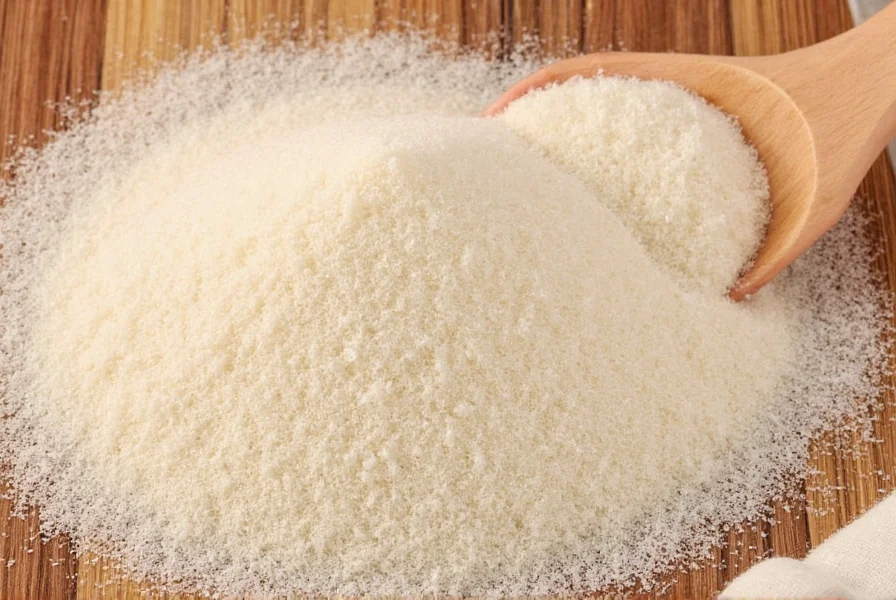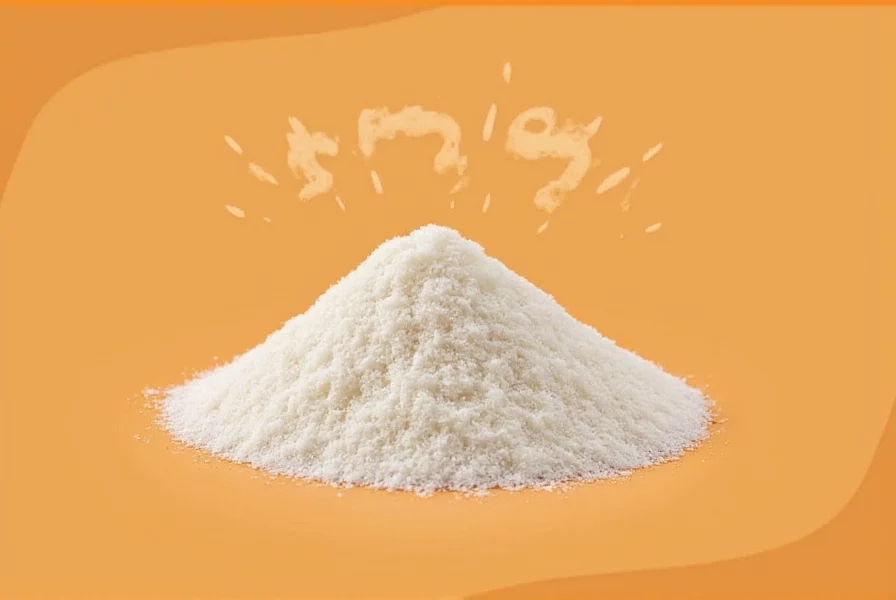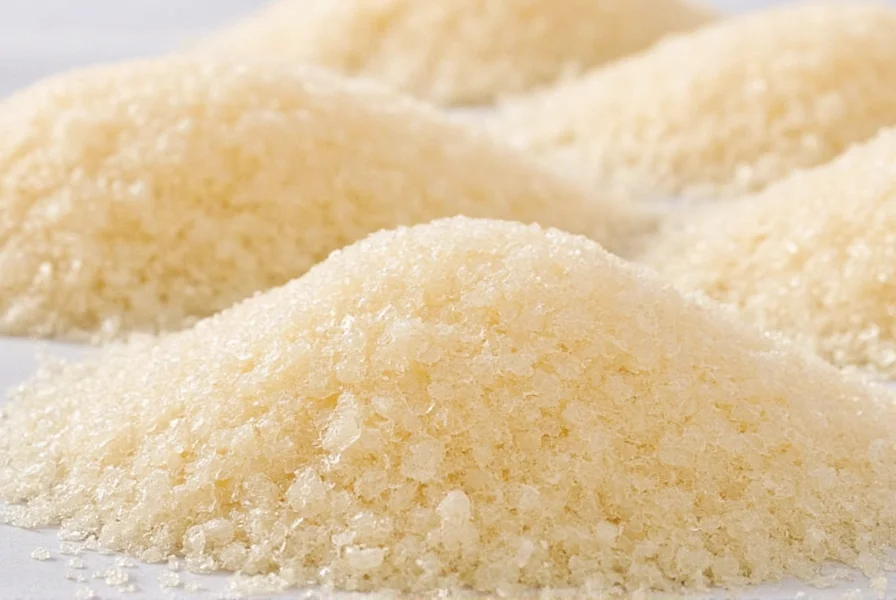Demerara sugar is a minimally processed, natural cane sugar with large, crunchy crystals and a rich caramel flavor. Originating from the Demerara region of Guyana, it retains natural molasses during production, giving it a golden-brown color and distinctive taste. Unlike refined white sugar, demerara is not fully processed, making it a popular choice for those seeking a less refined sweetener with more complex flavor profiles.

What Exactly Is Demerara Sugar?
Demerara sugar is a type of raw cane sugar that undergoes minimal processing. It gets its name from the Demerara region in Guyana, where it was historically produced. Unlike white sugar, which is fully refined and stripped of molasses, demerara sugar retains some natural molasses during production. This gives it its characteristic golden-brown color, larger crystal size, and subtle caramel notes.
According to the United States Department of Agriculture (USDA), demerara sugar is classified as a "raw sugar" that is produced by evaporating sugarcane juice and crystallizing the resulting syrup without complete refining. This process preserves some of the natural molasses content, which contributes to its unique flavor and texture.
Flavor & Texture: The Sweet Difference
Demerara sugar stands out from other sweeteners due to its specific characteristics:
- Flavor Profile: Rich caramel and molasses notes with earthy undertones, but less intense than brown sugar
- Texture: Large, coarse crystals that remain crunchy when used as a topping
- Moisture Content: Higher than white sugar but lower than brown sugar, giving it a slightly sticky texture
The Food and Drug Administration (FDA) classifies demerara sugar as a "natural sweetener" that can be used in food products. Its unique texture makes it ideal for applications where you want visual appeal and crunch rather than complete dissolution.
Where Can You Use Demerara Sugar?
Demerara sugar is versatile in culinary applications, particularly where texture and flavor enhancement are desired:
- Coffee and Tea: Perfect for stirring into hot beverages for a rich, caramelized sweetness
- Baking: Ideal for cookie tops, scones, and crumbles where you want a crunchy texture
- Rubs and Marinades: Adds depth to meat rubs when combined with spices
- Cocktails: Creates beautiful caramelized rims on glasses for specialty drinks
- Breakfast Bowls: Sprinkled over oatmeal, yogurt, or fruit for added texture and flavor

| Sugar Type | Flavor | Texture | Best For |
|---|---|---|---|
| Demerara | Caramel, earthy, molasses notes | Coarse, crunchy | Garnishes, coffee, scones, cocktails |
| White Granulated | Clean, neutral sweetness | Fine, smooth | Baking, sauces, everyday use |
| Brown Sugar | Molasses-rich, buttery | Soft, moist | Moist cakes, gingerbread, BBQ sauces |
| Raw Cane Sugar | Mild molasses flavor | Medium grain | Desserts, beverages |
| Coconut Sugar | Nutty, caramel-like | Moist, clumpy | Low glycemic index recipes, paleo-friendly dishes |
Buying Guide: How to Choose the Best Demerara Sugar
When selecting demerara sugar, look for these quality indicators:
- Crystal Size: Medium to large crystals for texture; smaller crystals for better dissolution in liquids
- Packaging: Airtight containers or resealable bags to prevent moisture absorption
- Organic Certification: Look for USDA Organic certification if you prefer non-GMO products
- Color Consistency: Uniform golden-brown color indicates proper processing and minimal impurities
Top Brands to Consider:
| Brand | Features | Best For |
|---|---|---|
| Florida Crystals Organic Demerara | Non-GMO, USDA Organic certified, sustainably sourced | Eco-conscious cooks and bakers |
| Bobs Red Mill Demerara Sugar | Coarse texture, consistent crystal size | Decorating cookies and muffins |
| Nature's Choice Organic Demerara | Rich molasses flavor, fair trade certified | Coffee lovers and health-focused buyers |
Storage Tips for Long-Lasting Goodness
Proper storage maintains demerara sugar's quality and prevents clumping:
- Airtight Containers: Transfer to sealed glass jars or plastic containers
- Use Dry Utensils: Always use clean, dry spoons or scoops to avoid moisture introduction
- Humidity Control: Add uncooked rice grains to absorb excess moisture
- Storage Location: Keep in a cool, dark place away from heat sources like ovens or stovetops
- Shelf Life: Properly stored, demerara sugar can last indefinitely, though flavor is best within 1-2 years
Frequently Asked Questions
What is demerara sugar made from?
Demerara sugar is made from sugarcane juice that undergoes partial refining. Unlike white sugar, which is fully processed to remove all molasses, demerara sugar retains some natural molasses during production. This minimal processing preserves the sugar's natural golden color and caramel flavor. According to the USDA, demerara is classified as a "raw sugar" that is produced by evaporating sugarcane juice and crystallizing the syrup without complete refining.
Is demerara sugar the same as brown sugar?
No, they are different. Brown sugar is typically made by adding molasses back to refined white sugar, while demerara sugar naturally retains some molasses during minimal processing. Demerara also has larger, crunchier crystals compared to the finer texture of most brown sugars. The FDA classifies demerara as a "raw sugar" while brown sugar is considered a "refined sugar with added molasses."
Can I substitute demerara sugar for white sugar in recipes?
You can substitute demerara for white sugar in a 1:1 ratio, but be aware that it will add a subtle caramel flavor and may affect texture due to its larger crystals. It works best in recipes where you want that rustic texture and deeper flavor, like coffee, crumbles, or cookie toppings. For delicate cakes or meringues, white sugar is usually better. The American Bakers Association recommends using demerara for applications where texture is desired rather than complete dissolution.
Is demerara sugar healthier than regular sugar?
Nutritionally, demerara sugar is very similar to white sugar. According to the USDA Food Database, both contain approximately 16 calories per teaspoon and 4 grams of carbohydrates. While demerara does retain trace amounts of minerals from the molasses (such as calcium, iron, and potassium), these amounts are too small to provide significant health benefits. The main advantage of demerara is its flavor profile rather than nutritional differences.
Why is demerara sugar more expensive than regular sugar?
Demerara sugar costs more because it undergoes less processing than white sugar. The minimal processing preserves more natural molasses and results in larger crystals. Additionally, many demerara sugar brands are produced using traditional methods and may be certified organic or fair trade, which contributes to the higher price point. The Specialty Food Association notes that artisanal and minimally processed ingredients typically command higher prices in the market.
Does demerara sugar expire?
Sugar doesn't technically expire as it's a natural preservative. According to the FDA, properly stored demerara sugar can last indefinitely. However, for best flavor and texture, it's recommended to use it within 1-2 years. Store it in an airtight container away from moisture to maintain quality.
Final Thoughts: Why Demerara Deserves Your Attention
Demerara sugar offers a unique combination of flavor and texture that makes it a valuable addition to any kitchen. Its minimal processing preserves natural characteristics that are lost in fully refined sugars, providing a richer sensory experience. Whether you're a home cook or professional chef, understanding how to use demerara sugar effectively can elevate your culinary creations.
For more information about sugar varieties and their applications, consult authoritative sources like the USDA Food Database, FDA guidelines, and the American Bakers Association.

For more culinary insights and food science information, visit our Food Science Resources page.










 浙公网安备
33010002000092号
浙公网安备
33010002000092号 浙B2-20120091-4
浙B2-20120091-4